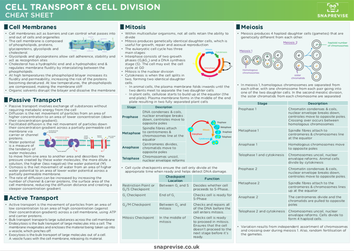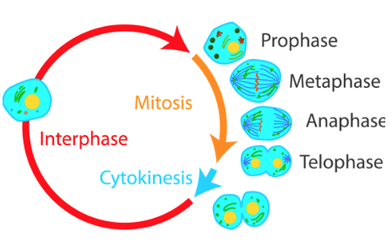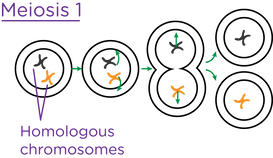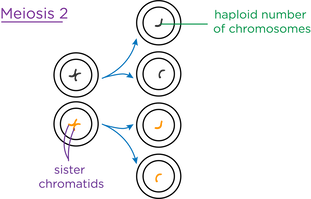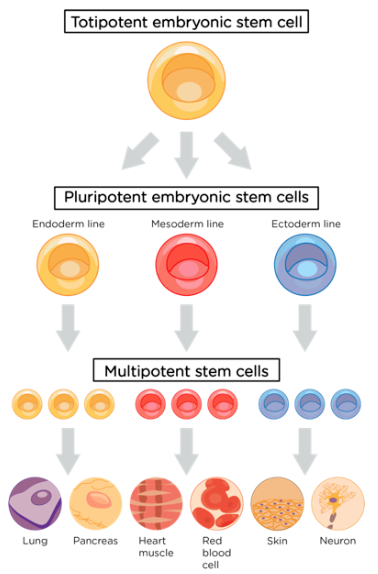A-LEVEL BIOLOGY OCR NOTES
cell division, cell diversity and cell organisation
Mitosis
- Within multicellular organisms, not all cells retain the ability to divide
- Mitosis produces genetically identical daughter cells, which is useful for growth, repair and asexual reproduction
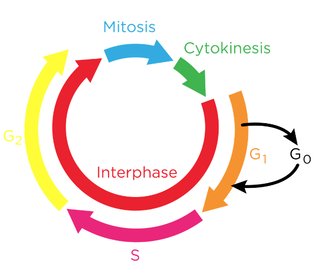
- The eukaryotic cell cycle has three main stages:
- Interphase consists of two growth phases (G1& G2) and a DNA synthesis stage (S). The cell may exit the cell cycle at G0
- Mitosis is the nuclear division
- Cytokinesis is when the cell splits in two, forming two identical daughter cells.
- In animal cells, the plasma membrane folds inwards until the two dents meet to separate the two daughter cells
- In plant cells, cellulose starts to build up at the equator (the end plate). Plasma membrane forms in the middle of the end plate resulting in two fully separated plant cells
- In animal cells, the plasma membrane folds inwards until the two dents meet to separate the two daughter cells
Stage |
Description |
Prophase |
DNA condenses & coils, nuclear envelope breaks down, centrioles move to opposite poles |
Metaphase |
Spindle fibres attach to centromeres & chromosomes line at the equator |
Anaphase |
Centromeres divides, chromatids move to opposite poles |
Telophase |
Chromosomes uncoil, nuclear envelope reforms |
- Cell cycle checkpoints ensure the cell only divide at the appropriate time when ready and helps detect DNA damage.
Checkpoint Location |
Function |
|
Restriction Point or G1/S Checkpoint |
Between G1 and S |
Decides whether cell proceeds to S-Phase.. |
G1 Checkpoint |
End of G1 |
Checks cell is ready for S-Phase |
G2/M Checkpoint |
Between G2 and mitosis |
Checks and repairs all of the DNA before the cell enters mitosis. |
Mitosis Checkpoint |
In the middle of mitosis |
Checks cell is ready to proceed in mitosis. Ensures that the cell doesn't proceed to the next stage before it's ready. |
Meiosis
- Meiosis produces 4 haploid daughter cells (gametes) that are genetically different from each other.
- In meiosis 1, homologous chromosomes are separated from each other, with one chromosome from each pair going into one of the two daughter cells. In the second meiotic division, the sister chromatids from each chromosome are separated
Stage |
Description |
Prophase 1 |
Chromatin condenses & coils, nuclear envelope breaks down, centrioles move to opposite poles. Crossing over occurs between homologous chromosomes |
Metaphase 1 |
Spindle fibres attach to centromeres & chromosomes line at the equator |
Anaphase 1 |
Homologous chromosomes move to opposite poles |
Telophase 1 and cytokinesis |
Chromosomes uncoil, nuclear envelope reforms. Animal cells divide by cytokinesis |
Prophase 2 |
Chromatin condenses & coils, nuclear envelope breaks down, centrioles move to opposite poles. |
Metaphase 2 |
Spindle fibres attach to the centromeres & chromosomes lines up at the equator |
Anaphase 2 |
The centromeres divide and the chromatids are pulled to opposite poles |
Telophase 2 and cytokinesis |
Chromosomes uncoil, nuclear envelope reforms. Cells divide to form 4 haploid cells. |
- Variation results from independent assortment of chromosomes and crossing over during meiosis 1. Also, random fertilisation of the gametes.
Stem Cells
- Stem cells are undifferentiated cells that are able to express all of their genes and divide by mitosis.
- During development, the stem cells undergo cell differentiation. This is the process by which cells become specialised for different functions.
- Fully developed cells are unable to divide by mitosis.
Stem Cell |
Ability |
Totipotent |
Can divide and differentiate into any type of cell. |
Pluripotent |
Can self-renew and differentiate into any type of cell except the cells that make up the placenta. |
Multipotent |
Can only differentiate and divide into a limited number of cell types |
Unipotent |
Can only differentiate into a single type of cell e.g. cardiomyoblasts can only differentiate into cardiomyocytes. |
- Totipotent stem cells are only present in mammals in the first few cell divisions of an embryo. During development, totipotent cells become specialised by expressing different genes and producing different proteins.
- Induced pluripotent stem cells are unipotent stem cells that have been reprogrammed to become pluripotent by using protein transcription factors to express genes associated with pluripotency.
- Pluripotent stem cells can be used to replace cells and treat human disorders like leukaemia and diabetes
- Bone marrow stem cells can differentiate into any type of blood cell
- Meristem cells in plants are involved in the production of new xylem and phloem tissue
Specialised Cells
- Erythrocytes have a large SA:V, with their biconcave shape. They lack a nucleus, so more haemoglobin can be stored
- Neutrophils have a multilobed nucleus allowing them to move and engulf material more easily
- Sperm cells have a tail to allow movement. There is a high density of mitochondria to provide ATP to the tail. Sperm cells have a streamline shape and a specialised lysosome (acrosome) that contains digestive enzymes to enter an egg cell
- Squamous epithelial cells are thin and flat to reduce the diffusion distance for gas exchange.
- Ciliated epithelial cells in the trachea have cilia to move mucus along the trachea
- Palisade cells contain lots of chloroplasts, are long and cylindrical allowing close packing. The chloroplast can be moved by the cytoskeleton to maximise light absorption
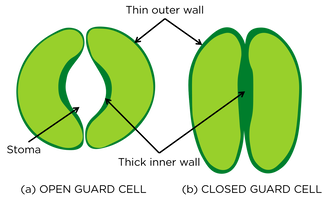
- Guard cells control the opening and closing of the stomata. ATP is used to pump K^+ ions into the cell, making water move in by osmosis in order to open the stomata for gas exchange
- Root hair cells have protrusion to increase their surface area for water absorption. They also have protein pumps and lots of mitochondria to transport minerals into the cell in order to lower the cells water potential.

